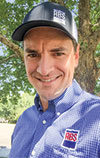In a dairy herd, efficiency and profitability can be achieved or lost depending on the successful balance between production and reproduction. Better reproductive performance benefits the herd directly by decreasing the days open and the average days in milk (DIM), placing cows closer to peak than to late lactation in their curve, and consequently producing more milk per cow per day.
Also, optimal reproduction performance benefits culling decisions, since a higher selection pressure can be applied to remove lower producing cows. On the other hand, a cow that remains open for a longer time due to failure of reproduction will delay pregnancy and will increase direct costs in many ways, including extra semen, labor, veterinarian services and drugs. Indirect costs can also increase by keeping these cows in their late lactation portion of the curve longer, thereby producing less milk on average and making more animals candidates for culling and earlier replacement.
In spite of the recent slight improvement to revenue in the milk market due to the decrease of production costs, the daily decisions made on a dairy are always complex, influenced by a multitude of economic, environmental and biological factors that affect the future genetics of the herd. Then, a smart decision does not necessarily mandate trimming costs to maximize efficiencies. Often, choosing a lower genetic merit for a given dairy herd can ultimately be counterproductive to business success.
This article examines ways to maximize current resources by using more effective reproductive and general management.
1. Focus on the little things to make a big difference
The first opportunity to enhance fertility results within the current budget is focused on trivial factors such as heat detection accuracy, careful semen handling and A.I. technique. These factors can be improved by the A.I. technician, but many times may be overlooked by the manager. It is well known that the proportion of cows not in or near heat when inseminated may vary from 0 to 60 percent among dairies, indicating individual herd issues at play. This highly variable heat detection accuracy should be considered a significant cause of low conception rates (CR). A study by Dr. Joseph Dalton in Idaho reported that the average heat detection rate for 10 herds varied from 49 to 70 percent, showing opportunity to achieve a higher accuracy on detecting heat.
Regarding semen handling, Graham et al. found that many A.I. schools believe a person that had been trained to be a breeder will forever be efficient in that task. However, studies have revealed a lower CR among the same A.I. technicians four months before versus four months after retraining. Other interesting data related to A.I. consistency, experience and technique disclose cases of professional A.I. technicians whose performance was compared with herdsmen inseminators. The difference in CR between those groups was impressive and showed significantly more favorable results by the first group (45 percent versus 27 percent). Retraining herdsmen inseminators by experienced A.I. professionals can easily impact fertility numbers.
2. Check protocol compliance
The second opportunity that actually is a complement to the first one is compliance with timed-A.I. protocols.
It is really important that the dairy crew understands the importance of giving the right injection to the right cow at the right time, to be committed to the success of the dairy. As an example, in a timed-A.I. protocol with five injections, such as the Presynch-Ovsynch synchronization program, even a rate as high as 95 percent compliance is not enough, because this 95 percent compliance at each hormone administration translates to only 77 percent compliance across the program. As part of a retraining for breeders, it is important to show these numbers to assure they know the importance of achieving all the cows assigned to this type of reproductive program.
3. Assemble a repro dream team
The third opportunity to be profitable without compromising genetic quality is to establish a team of accurate, careful, knowledgeable and committed people to achieve the first two opportunities.
According to Schuenemann et al., many dairy operations have been using advisory teams comprised of veterinarians, nutritionists and consultants as a critical tool to improve personnel performance, better communicate strategies, resolve issues and conflicts, implement and review protocols, and include employees as part of the decision process. Many times, these professionals are provided by the supplier companies as a means to add value to their service. So, in general, it does not represent extra costs to the dairy.
These professionals can help on building effective teams, which requires a high commitment, clear objectives, trust and involvement of both manager and employee, willingness to take risks, time, resources and commitment to training and retraining.
Schunemann et al. also mentioned that finding the right task for the right employee is a time-consuming process, but this may be the most important part of building an effective work team in a dairy operation. Each area of the dairy needs different people with distinct personal traits to achieve excellence in their respective tasks. For instance, the A.I. technicians checking eligible cows for reproduction need to know all the secondary signs of a cow in heat, mastering the “art” of recognizing a cow ready to be bred.
To distinguish and cultivate those traits in a person, the herd manager needs sensitivity to closely observe and monitor the training. Also, supervised and hands-on training can improve skills and diligence. Frequent evaluation of performance and retraining programs should be the priorities for the dairy. Finally, giving tools to the employees to better do their tasks and increasing their opportunities to take part in the decision-making process will enhance their sense of job satisfaction, self-esteem and provide a means of recognizing and motivating them – all factors that affect overall herd performance. ![]()
References omitted but are available upon request. Click here to email an editor.

-
Anibal Ballarotti
- Technical Service Consultant
- ABS Global
- Email Anibal Ballarotti
PHOTO: Staff photo.







